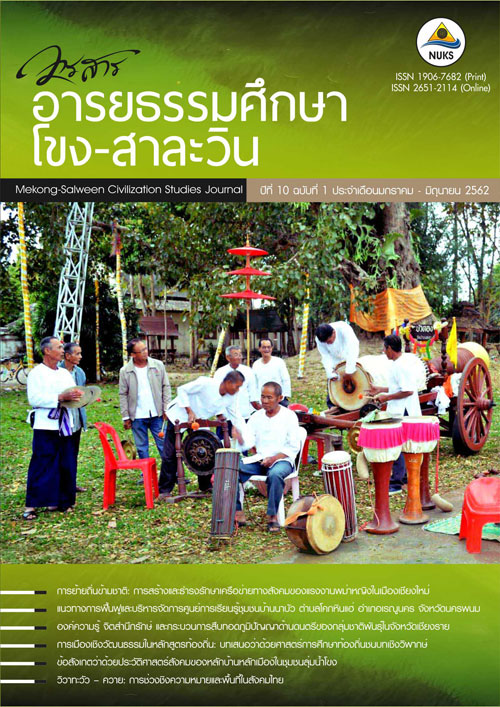ข้อสังเกตว่าด้วยประวัติศาสตร์สังคมของหลักบ้านหลักเมืองในชุมชนลุ่มน้ำโขง ข้อสังเกตว่าด้วยประวัติศาสตร์สังคมของหลักบ้านหลักเมืองในชุมชนลุ่มน้ำโขง
Main Article Content
บทคัดย่อ
บทความวิชาการนี้เป็นความพยายามในการตั้งข้อสังเกตต่อการเปลี่ยนแปลงของความเชื่อหลักบ้านหลักเมืองและความเชื่ออื่นที่เกี่ยวข้อง โดยพยายามที่จะอธิบายเชิงสำรวจอย่างกว้าง ๆ ถึงกระบวนการคลี่คลายความหมายและความสำคัญของหลักบ้านหลักเมืองสองฝั่งโขง ซึ่งด้านหนึ่งคือความพยายามที่จะสะท้อนให้เห็นถึงภาพพัฒนาการและการเปลี่ยนแปลงของของชุมชนท้องถิ่นลุ่มน้ำโขงผ่านความเชื่อหลักบ้านหลักเมืองตั้งแต่ช่วงทศวรรษ 2500-ปัจจุบัน (พ.ศ.2561) ทั้งนี้โดยได้เลือกหยิบยกบางประเด็นขึ้นมานำเสนอ ประกอบด้วย 1) “การรับรู้และความเชื่อเกี่ยวกับหลักบ้านหลักเมือง” โดยเฉพาะประเด็นความเชื่อที่ว่ามีการฝังคนทั้งเป็นไว้ข้างใต้เสาหลักเมือง ทั้งยังถูกผลิตซ้ำในสื่อสมัยใหม่ด้วยนั้น พบว่าไม่ปรากฏมีหลักฐานใดรองรับความเชื่อดังกล่าวเลย 2) “หลักบ้านหลักเมืองกับการสร้างสำนึกชุมชนของหมู่บ้านในยุคสงครามเย็น” พบว่าชุมชนที่เพิ่งก่อตั้งใหม่ในช่วงทศวรรษ 2510-2520 ส่วนหนึ่งตั้งขึ้นตามนโยบายป้องปรามของรัฐไทยเพื่อสกัดกั้นการแพร่กระจายของลัทธิคอมมิวนิสต์ ดังนั้น การตั้งหลักบ้านจึงทำหน้าที่เป็นทั้งศูนย์กลางของทางจิตวิญญาณ สร้างสำนึกความเป็นชุมชนและยืนยันการมีตัวตนเชิงพื้นที่ของหมู่บ้านใหม่เหล่านี้ 3) “หลักบ้านหลักเมืองกับการขับไล่ผีปู่ตาและการผลิตซ้ำทางวิชาการ” ทั้งนี้ตั้งแต่ทศวรรษ 2520 มีการผลิตซ้ำองค์ความรู้ทางวิชาการว่าผีปู่ตามีบทบาทในการจัดระเบียบทางสังคมของหมู่บ้านชนบทอีสานโดยไม่พิจารณาบริบทและมิติเวลา ดังนั้น เมื่อมีการขับไล่ผีปู่ตาออกจากหมู่บ้าน กลับไม่สามารถอธิบายปรากฏการณ์นั้นได้ 4) “หลักบ้านหลักเมืองกับการผลิตซ้ำอุดมการณ์ของพุทธศาสนาและรัฐ” พบว่าปฏิบัติการขับไล่ผีปู่ตาออกจากชุมชนหมู่บ้านตั้งแต่ทศวรรษ 2500 ได้อาศัยพระสงฆ์ (ฝ่ายธรรมยุติกนิกาย) เป็นผู้ดำเนินการหลัก โดยสร้างหลักบ้านขึ้นมาแทนและให้ความหมายใหม่ว่าหลักบ้านไม่ใช่ผีแต่เป็นหลักพระธรรมซึ่งมีความบริสุทธิ์และเหนือกว่าผี นอกจากนี้ กรณีการตั้งหลักเมืองแห่งใหม่ของเมืองเวียงจันทน์นับเป็นตัวอย่างของการสร้างหลักเมืองเพื่อผลิตซ้ำอุดมการณ์ของรัฐชาติ โดยทำหน้าที่เชื่อมโยงอดีต-ปัจจุบัน-อนาคต ของชาติลาวเข้าด้วยกัน
Downloads
Article Details
เอกสารอ้างอิง
Atiwanichayawong, N. (2014, July-December). Northeast Rural People and Livelhood: Change by Age. Sociology and Anthropology Journal. 33(2): 103-127.
Chanapantu, J. (2018). Lak bue Ban: Holy Pillars of Northeast Communities. Retrieved on 9 December 2018 from https://www.silpa-mag. com/club/miscellaneous/article_8407
Dhammawatra, J. (1987). Royal Archive of Lao: Luangprabamg Vientien Muang Puan and Champasuk. Mahasarakham: Research Institute of Art and Culture, Srinakarintarawiroj University, Mahasarakham Campus.
Durkheim, Emile. (1995). The Elementary Forms of Religious Life. Translated by Karen E. Field New York: The Free Press.
Fine Arts Department. (1978). Prarajakamnodmai Lesson 35 in Kodmaitrasamduong Law. Bangkok: Udomsuksa.
Harper, Charles L. (2001). Environment and Society: Human Perspectives on Environmental Issues. New Jersey: Prentic-Hall.
Hayashi, Y. (2003). Practical Buddhism among the Thai-Lao: Religion in the Making of a Region. Bangkok: Chulalongkorn University Press.
Janta, R. (2007, January). Kaoban Kaophi SuaBan Suamuang: Family System and Community Organization in Economic Zone of Upper Northern Culture. Muangboran. 33(1): 32-47.
Jirattikorn, A. (1996). Recalling Ceremony of Sao Sa kang of Lua. Art and Culture. 17(5): 132-139.
Kaewtep, K. (1984). Consciousness of Peasant: Theory and Approach of Political Economy Analysis. Bangkok : Chao Pra Ya Printing.
Kanjanapan, A. (2001). Dynamic and Potential of Community in Development. Bangkok: The Thailand Research Fund.
Keyes, Charles. (2010). Cosmopolitan Villagers and Populist Democracy in Thailand. Paper to be presented at Conference on Revisiting Agrarian Transformations in Southeast Asia, May 13-15, 2010, Chiang Mai: Thailand.
Kitirianglarp, K. (2016). Research Report on Imperialist Anthropology: Invention of Rural Communities and Origin of Anthropology in Cold War Era. Bangkok: the Thailand Research Fund.
Krasasintu, C. (1982). Pra Lak Muang. Bangkok: The War Veterans Organization of Thailand Under Royal Patronage of His majesty the King.
Luangpu Tongma Tawaro. (2017). Holy Monk of Northeast Region, retrieved on 9 December 2017, from https://esan108.com/ หลวงปู่ทองมา-ถาวโร.html.
Ministry of Information, Culture and Tourism, Laos People's Democratic Republic. (2012). History of the City Pillar Shrine, Vien Tien: Laos People's Democratic Republic..
Mukdawijitra, Y. (2005). Reading Community Culture: Rhetoric and Politics of Ethnography of Community Culture. Bangkok: Pha diew kan Printing.
Ogad, S. Villager of community of Sri Muang Temple, Vien Tien, Interviewed on 14 July, 2017.
Patraratananan, S. (2012). Politics of Farmer Society: Condition of Formation of Red Shirt in Northeast Region Translated by Manee, A. Pha Diew kan 10(2):123-142.
Phuongphusakul, A. (2000). Space in Social Science. Social Science Journal. 12(2): 66-67.
Phongsuksawat, W. (2008). Lukmuang Lanchai hang Rajaanajak. Bangkok: Bannangsuaokamin.
Praya Prakang. (1972). Rachatirat. Pranakorn: Praewittaya.
Praya Pracha Kijkornrajak. (1973). PongsawadanYonok. Bangkok: Kungwittaya.
Prince Damrong Rajanubhab. (1958). Ruang Tiew Ti Tang Episode 3: Lao Ruang Tiew Monton Pechraboon. BangKok: Fine Arts Department.
Prince Damrong Rajanubhab. (1962).Pongsawadan Lan Chang in Prachumpongsawadan Volume 2. Bangkok: The Teachers' Council of Thailand.
Public Relation Office, Chiang Mai. (2017). Suwan Kamdaeng Legend, retrieved on 9 December, from www.prdnorth.in.th/northtour/ historyintakin.html.
Samutawanich, C. and Sanitwong, K. (2003). Environment and Security: Security of State and insecurity of Citizen. 2nd edition Bangkok: Sukhum and son Company.
Santasombat, Y. (1995). New Gun and Ancient Devil in Samurai’s Wife: Anthropological Short Stories. pp.113-131. 3rd edition: Kobphai printing.
Saraya, T., (2001). History of Siam Peasant. 2nd edition Bangkok: Ammarin Printing.
Sattayanurak, A. (2003). Buddhism and Political Concept in King Rama I Period (1782-1809).Bangkok: Matichon.
Sattayanurak, A. (2014). Change to Urbanity of Rural Society: Process of moving to Democracy. Humanity and Social Science, Suratthani Rajjapak University 6(12): 93-120.
Scott, J. (1976). The Moral Economy of the Peasant: Rebellion and Subsistence in Southeast Asia. New Haven and London: Yale University Press.
Singsatit, T. (1956). Right River Bank of Mekong Volume 2. Bangkok: Kangwittaya.
Siri-ngam, S. (2016, January-March), National Strategy of Thai State in Relaxation period. The National Defence College of Thailand Journal, 58(1): 9-21.
Snodgrass, A. (1984). The symbolism of the Stupa Translated by Sirikan, P. Bangkok: Thammasat University.
Painoi, S. (2000, December). The Burial Ceremony of People under the pillar of the city Sarakadee. 16(190) : 121.
Suntornphesat, S. (1968). Sociology of Northeastern Communities. Bangkok: The Social Science Association of Thailand.
Taylor, J.L. (1996) .Forest monks and the Nation-State: an anthropological and historical study in Northeastern Thailand. Singapore: Institute of Southeast Asian Studies.
Therasassawat, S., et al. (1985). Research Report on Economic History of Chee River Basin since 1932-1985. Khonkaen: Faculty of Humanity and Social Science, KhonKaen University.
Therasassawat, S., et al. (1998). Isan History after World War II-Present Day. Khonkaen: Kangwittaya Printing.
Therasassawat, S. (2003).Economic History of Northeast Rural Communities, 1945-2001. Bangkok: Chulalongkorn University Bookcentre.
Terwiel, B.J. (1978, July). The origin and meaning of the Thai City Pillar. Journal of the Siam Society. 66(2): 159-172.
Walliphodom, S. (1995). Civilization of Issan. Bangkok: Matichon.
Wattanaphuti, C. (1986). Approach of Study and Reality in Society: Anthropological Study of Thai Society. pp. 20-35. Bangkok: Research Institute of Society, Chulalongkorn University.
Werawong, S. (1986). Heet Sib Song. Translated by Praprasert, U. Ubonrajathani: Art and Culture Center, Ubonrajathani College of Teacher Training.
Werawong, S. (1992). Lao History. Bangkok: Company of Pikanes Printing Center.
Wolf, E.R. (1984). Peasant Society Translated by Suntornpesat, S. Chiang Mai: Library of Chiang Mai.
Wongtes, S. (2018).Ya Mae Se Muang Female Ancestor Ghost at Se Muang Temple in Vien Tien. Retrieved on 29 December, from https://www.matichon.co.th/news/410311
Yimrewat, P. (2001).History of SibsongJutai. Bangkok: Sangsan.
Yudee, C. (1989). Chin Yudee : Founder of Thai Pre History Subject. Bangkok: Pikanes Printing.


